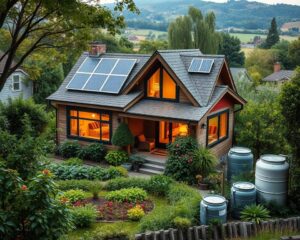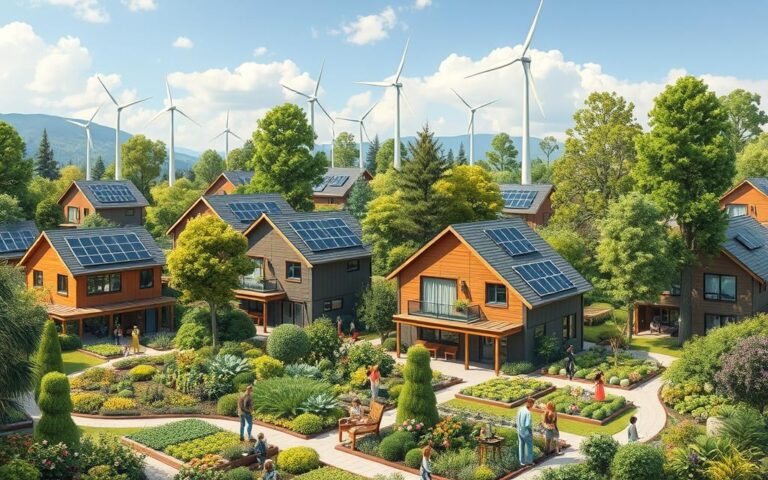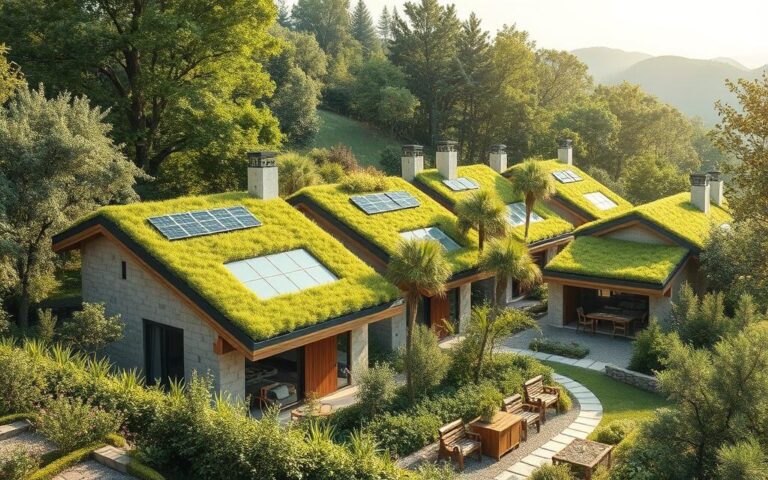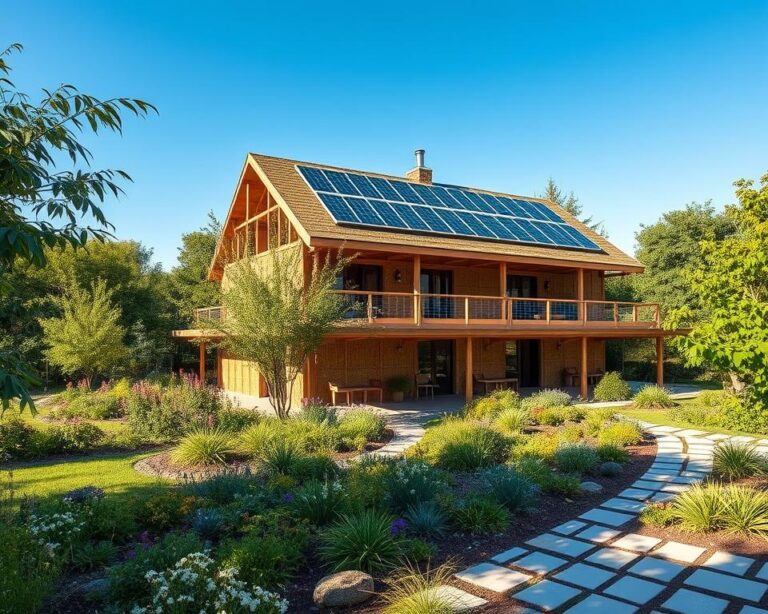Did you know over a third of American homes have old refrigerators? Replacing them with Energy Star models can stop over 5,000 pounds of carbon pollution in five years. This shows how big of a difference you can make by choosing energy-efficient homes.
Lowering your carbon footprint is key in the battle against climate change. It also helps you save money and live in a healthier home.
In this guide, we’ll look at how small changes can make a big difference. We’ll talk about picking the right appliances and improving your home’s insulation. Every choice you make helps us move towards a greener future. Let’s explore how to make your home more energy-efficient and better for you and the planet.
What are Energy-Efficient Homes?
Energy-efficient homes aim to use less energy without sacrificing comfort. They use special designs and technologies to be efficient. Features include good insulation, energy-saving windows, and smart heating and cooling systems.
Definition and Key Features
At their core, energy-saving homes use new materials and methods to save energy. Here are some key features:
- Ultra-efficient construction: Uses sustainable materials and systems, often with solar power.
- Passive solar design: Uses nature to control temperature, keeping it warm in winter and cool in summer.
- Cool roofs: Have reflective materials to keep homes cool in warm weather.
- Smart home technology: Includes devices that adjust energy use automatically, helping save energy.
Benefits for Homeowners
Choosing sustainable homes has many benefits for homeowners. Some of these include:
- Lower utility bills: These homes use up to 20% less energy, saving money.
- Environmental impact: They help reduce pollution and carbon footprint.
- Increased home value: Eco-friendly homes are more appealing to buyers, boosting their value.
Considering these points, energy-efficient homes are a wise choice. They save money and help the environment, making them a step towards a greener future.
Why Choose Energy Efficiency?
Choosing energy efficiency brings big benefits in today’s world. It helps the environment and saves money. Making your home eco-friendly can change it for the better and save your wallet.
Environmental Impact
Energy-efficient homes help fight climate change. They use less energy thanks to insulation and ENERGY STAR appliances. This cuts down greenhouse gas emissions.
For example, ENERGY STAR buildings use 35% less energy than usual. Green home design makes your home more comfortable. It also helps the planet.
Financial Savings
Energy-efficient homes save money over time. Even though they cost more upfront, like the $700 for an energy-efficient water heater, you save a lot later. You could save up to $3,500.
Using these heaters can save over $550 a year. Utility companies offer rebates from $25 to $1,000. This helps with the initial cost.
Small changes like programmable thermostats and energy-efficient appliances save a lot. They can cut heating and cooling bills by 10%. A home can save 5% to 30% a year by fixing drafts and using less energy for lighting.
These savings, along with helping the environment, show why energy-efficient choices are smart.
Assessing Your Home’s Energy Efficiency
Knowing how your home uses energy is key to being more eco-friendly. A home energy audit is a great way to start. It shows where your home uses a lot of energy and finds any waste.
Professional energy auditors can spot problems like drafts and bad insulation. These are common in older homes.
Home Energy Audit
A home energy audit checks how well your home saves energy. Auditors use special tools to find and fix problems. This helps you understand how much energy your home uses.
Homeowners might get help paying for this check. Some states, like New York, offer free energy checks for certain homes. These checks suggest important changes to cut down energy use.
Identifying Areas for Improvement
After the audit, you’ll know what needs fixing. You might need to:
- Make insulation better to meet new standards.
- Put vapor barriers in the attic for better insulation.
- Clear vents in the attic to improve airflow.
- Use baffle vents for good ventilation.
- Choose insulation with an R-value of 25 for basements and crawl spaces.
By making these changes, your home will use less energy. This makes your home more comfortable and saves money. Making these changes turns your home into a green, eco-friendly space.
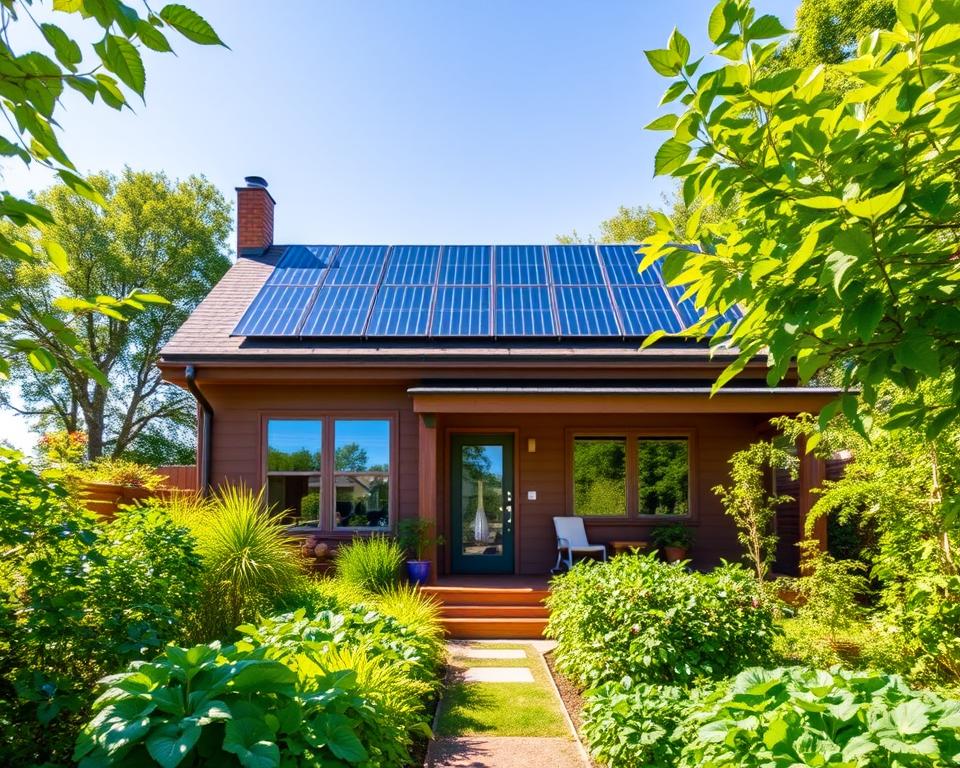
Energy-Efficient Building Materials
Choosing the right energy-efficient building materials is key to sustainable housing. These materials cut down on energy use and help the environment. Since homes use about 21% of the U.S. energy, picking the right materials can save a lot.
Sustainable Options
Look for materials that save energy and are good for the planet. Here are some:
- Recycled steel: It’s green and uses 75% less energy to make than new steel.
- Hempcrete: It absorbs carbon dioxide and keeps your home warm.
- Strawbale construction: It keeps your home cool in summer and warm in winter.
- Insulated concrete forms: They use 20% less energy than wood frames in cold places.
Choosing Smart Insulation
Good insulation is vital for a cozy, energy-saving home. Smart insulation, like plant-based foam, keeps your home warm or cool. Here are some top picks:
- Spray foam insulation: It seals your home tight, saving lots of energy.
- Fiberglass insulation: Newer types have better R-values for better warmth.
- Low-E windows: They block heat flow, cutting down on your energy bills.
- Cool roofing materials: They reflect sunlight, keeping your home cooler and saving on cooling costs.
Upgrading Your Heating and Cooling Systems
Upgrading your heating and cooling systems is key to saving energy at home. Replacing old units with new, energy-efficient ones cuts down on energy use. This makes your home more comfortable and saves money on bills.
Choosing Energy-Efficient HVAC Systems
Heating and cooling use a lot of energy in homes. Installing ENERGY STAR certified units can save you about $140 a year. Systems with variable-speed fans also keep your home comfortable by adjusting to your needs.
It’s important to know about SEER and EER ratings when picking a system. A higher SEER means better efficiency. EER ratings tell you how efficient a system is under certain conditions. Replacing an old air conditioner can save you up to 40% on cooling costs. Regular maintenance keeps your systems running well and avoids expensive repairs.
Importance of Regular Maintenance
Keeping your systems in good shape is vital. Change your air filters every month or at least every three months. This boosts performance and saves energy. Seasonal maintenance checks can also prevent sudden breakdowns.
Proper installation and design of your HVAC system are crucial. A poorly installed system can waste up to 30% of energy, increasing your bills. Making sure your system fits your home size helps avoid energy waste and makes your home more comfortable.
| Maintenance Task | Frequency | Benefits |
|---|---|---|
| Change Air Filters | Monthly | Improved air quality, enhanced system efficiency |
| Seasonal Maintenance Checks | Start and End of Season | Prevents unexpected failures and costly repairs |
| Seal Ducts | As Needed | Improves system efficiency by up to 20% |
| Clean Drain Line | Annually | Prevents flooding and maintains proper functioning |
| Assess System Size | Every Upgrade | Optimizes energy usage and comfort |
By choosing the right HVAC system and keeping it maintained, you help the environment. You also get to enjoy a comfortable, eco-friendly home.
Smart Home Technology for Efficiency
Smart home technology makes your life easier and saves energy. It includes smart thermostats, energy monitors, and automated lights. These devices help you use less energy and live in a modern home.
Overview of Smart Devices
Smart home tech has many devices to save energy. Some popular ones are:
- Smart thermostats: Save 15-20% on energy by adjusting your home’s temperature based on your schedule.
- Smart outlets: Control your window ACs and fans from anywhere, saving energy.
- Smart LED light bulbs: Use 75% less energy than old bulbs, making them a green choice.
- Energy monitors: Show how much energy your home uses, helping you save more.
Automation for Energy Savings
Automation is key in a smart home for saving energy. You can set up devices to use energy wisely without losing comfort. For example:
- Automated schedules: Set lights and outlets to turn off when you’re not home, saving energy.
- Remote management: Control your home’s temperature and lights from your phone, even when you’re out.
- Occupancy-based adjustments: Thermostats adjust based on if you’re in the room, saving energy.
- Phantom load management: Stop energy waste from devices plugged in but not used.

Smart home tech boosts your home’s energy efficiency and supports a green lifestyle. Many utilities offer rebates for these energy-saving devices. By using smart home tech, you’re helping your home and the planet in the long run.
Energy-Efficient Appliances
Creating eco-friendly homes is all about using energy-efficient appliances. ENERGY STAR appliances are key. They help cut down on carbon emissions and make life easier.
Importance of ENERGY STAR Ratings
ENERGY STAR ratings mean an appliance is very efficient. They use much less energy than old models. This saves money and helps the planet.
Benefits of Modern Appliances
Modern, energy-efficient appliances offer many benefits:
- Cost Savings: An ENERGY STAR dishwasher can save 3,800 gallons of water over its life.
- Extended Lifespan: These appliances last 10 to 20 years, making them a smart choice.
- Increased Efficiency: ENERGY STAR washers use 20% less energy and 30% less water.
- Potential Tax Credits: You might get tax credits for making your appliances more efficient.
Switching to ENERGY STAR appliances helps your home use less electricity. This saves energy and money over time. It’s good for the planet and brings you modern conveniences.
| Appliance Type | ENERGY STAR Efficiency Improvement | Potential Annual Savings |
|---|---|---|
| Clothes Washer | 20% less energy, 30% less water | $90 |
| Dishwasher | 3,800 gallons saved over lifetime | $25 |
| Refrigerator | 9% more energy efficient | $100 |
| Dryer | Energy-saving performance | $100 |
Adding ENERGY STAR appliances to your home boosts energy efficiency. It shows your commitment to a greener lifestyle. The benefits last for years, helping you and future generations.
Utilizing Renewable Energy Sources
Using renewable energy in your home boosts energy efficiency and supports sustainable living. Solar panels and wind energy help cut down on fossil fuel use and lower bills.
Solar Panels for Homes
Solar energy systems are a favorite among homeowners. The cost to install solar panels is about $3 per watt. A 7,000-watt system costs around $21,000 and gives 20 to 35 kilowatt-hours of electricity daily.
Solar water heating systems are also effective but might need a backup. Costs range from $5,000 to $7,000. Solar energy is a green way to get electricity without pollution.
Wind Energy Considerations
Wind energy is another good option for homeowners in the right places. Small wind systems cost about $5 per 120 kilowatts to install. Costs range from $10,000 to $70,000.
Homeowners in windy areas can save a lot. They can also sell extra electricity back to the grid. This boosts energy independence and supports green building.
Enhancing Your Home’s Insulation
Proper insulation is key to an energy-efficient home. It acts as a barrier against the elements. This reduces the need for heating and cooling, saving you money and keeping you comfortable.
To improve your home’s insulation, look into different materials. Each has its own benefits. Understanding these can make your home more energy-efficient.
Types of Insulation Materials
There are many insulation options, each with its own advantages. Here are a few:
- Cellulose: Made from recycled paper, it’s eco-friendly and effective.
- Spray foam: It seals air well and fills gaps for better performance.
- Rigid foam boards: Great for foundations and exterior walls where stability is key.
Benefits of Proper Insulation
Smart insulation offers many benefits for homeowners. Here are some:
- Lower energy bills: It reduces the need for heating and cooling, saving money.
- Improved indoor comfort: A well-insulated home stays at a stable temperature, making it more comfortable.
- Better air quality: It keeps drafts out and prevents pollutants from entering.
- Supports eco-friendly houses: Efficient insulation helps reduce energy use and environmental impact.
| Insulation Type | R-Value (Per Inch) | Eco-Friendly | Best Use |
|---|---|---|---|
| Cellulose | 3.1 – 3.8 | Yes | Attics, walls |
| Spray Foam | 6 – 7 | Limited | Air sealing, irregular spaces |
| Rigid Foam Board | 4 – 6.5 | Depends on material | Basements, exterior walls |
Water Conservation Strategies
It’s key to use water wisely in our homes. By picking the right fixtures and habits, we cut down water use. This helps the planet too. Here are some smart ways to save water at home.
Efficient Fixtures and Appliances
Switching to water-saving fixtures and appliances is a big step. Many people look for these features when buying a home. Here are some good choices:
- High-efficiency toilets save up to 13,000 gallons a year.
- Showerheads with a flow rate under 2.5 gpm use half as much water.
- ENERGY STAR appliances save water and energy.
For example, dishwashers and washers with the ENERGY STAR label save a lot. They use less water and energy over time.
Collecting Rainwater
Using rainwater is another smart move. It lets you use rainwater for plants and other needs, cutting down on city water use. Greywater systems can even reuse up to 60% of household water.
Adding recirculation loops saves energy by getting hot water to fixtures faster. Fixing leaks can also save a lot of water. These steps show you care about the planet.
| Fixture/Appliance | Water Usage | Water Savings |
|---|---|---|
| High-Efficiency Toilet | 1.3 gpf | 13,000 gallons/year |
| Modern Showerhead | Less than 2.5 gpm | 50% compared to pre-1995 models |
| ENERGY STAR Dishwasher | Varies | 3,870 gallons/lifetime |
| ENERGY STAR Washing Machine | 33% less water | Compared to standard washers |
Moving Toward a Sustainable Lifestyle
Changing to a sustainable lifestyle is easy with small daily steps. Being aware of how much energy you use can greatly reduce your impact on the planet. Simple actions like recycling, cutting down on single-use plastics, and choosing to walk or bike can make a big difference.
Did you know that almost 40% of food in the U.S. ends up in landfills? This waste is huge for our environment. By making smart choices every day, you help achieve the goal of energy-efficient homes.
Simple Daily Changes
Making your daily life more sustainable is simple. Using energy-saving appliances can cut down on carbon emissions and save money. It’s also important to save water, especially with more people needing it.
Choosing water-saving devices is a step in the right direction. These small changes can add up and make a big difference.
Community Involvement and Impact
Getting involved in your community is key to spreading eco-awareness. Joining local green projects or initiatives can boost your impact and encourage others to live sustainably. Supporting local farmers, helping with clean-ups, or pushing for green policies are all ways to contribute.
Together, we can make energy-efficient homes common and protect these practices for the future. It’s all about working together and inspiring others to join us.

